Page 295 of 391
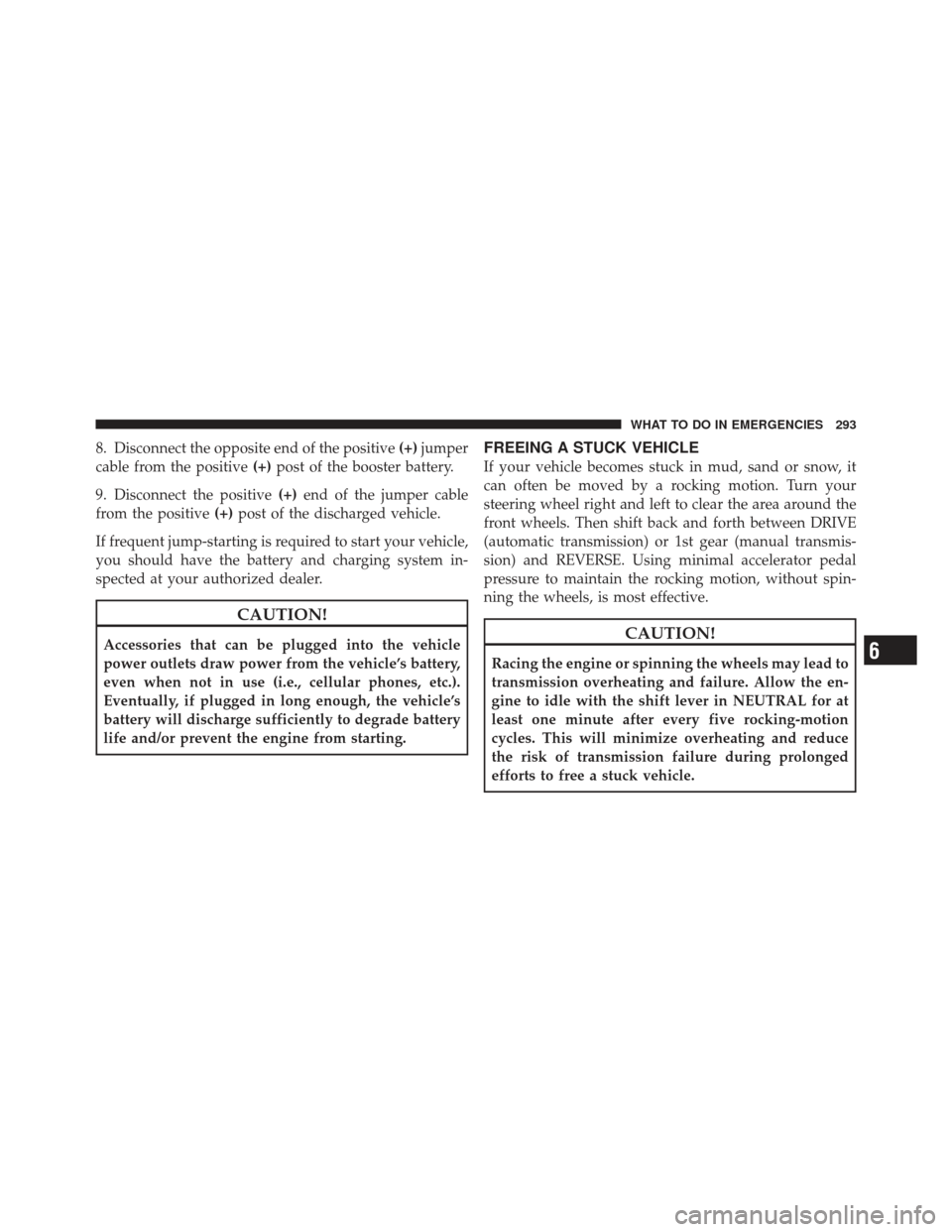
8. Disconnect the opposite end of the positive(+)jumper
cable from the positive (+)post of the booster battery.
9. Disconnect the positive (+)end of the jumper cable
from the positive (+)post of the discharged vehicle.
If frequent jump-starting is required to start your vehicle,
you should have the battery and charging system in-
spected at your authorized dealer.
CAUTION!
Accessories that can be plugged into the vehicle
power outlets draw power from the vehicle’s battery,
even when not in use (i.e., cellular phones, etc.).
Eventually, if plugged in long enough, the vehicle’s
battery will discharge sufficiently to degrade battery
life and/or prevent the engine from starting.
FREEING A STUCK VEHICLE
If your vehicle becomes stuck in mud, sand or snow, it
can often be moved by a rocking motion. Turn your
steering wheel right and left to clear the area around the
front wheels. Then shift back and forth between DRIVE
(automatic transmission) or 1st gear (manual transmis-
sion) and REVERSE. Using minimal accelerator pedal
pressure to maintain the rocking motion, without spin-
ning the wheels, is most effective.
CAUTION!
Racing the engine or spinning the wheels may lead to
transmission overheating and failure. Allow the en-
gine to idle with the shift lever in NEUTRAL for at
least one minute after every five rocking-motion
cycles. This will minimize overheating and reduce
the risk of transmission failure during prolonged
efforts to free a stuck vehicle.6
WHAT TO DO IN EMERGENCIES 293
Page 296 of 391
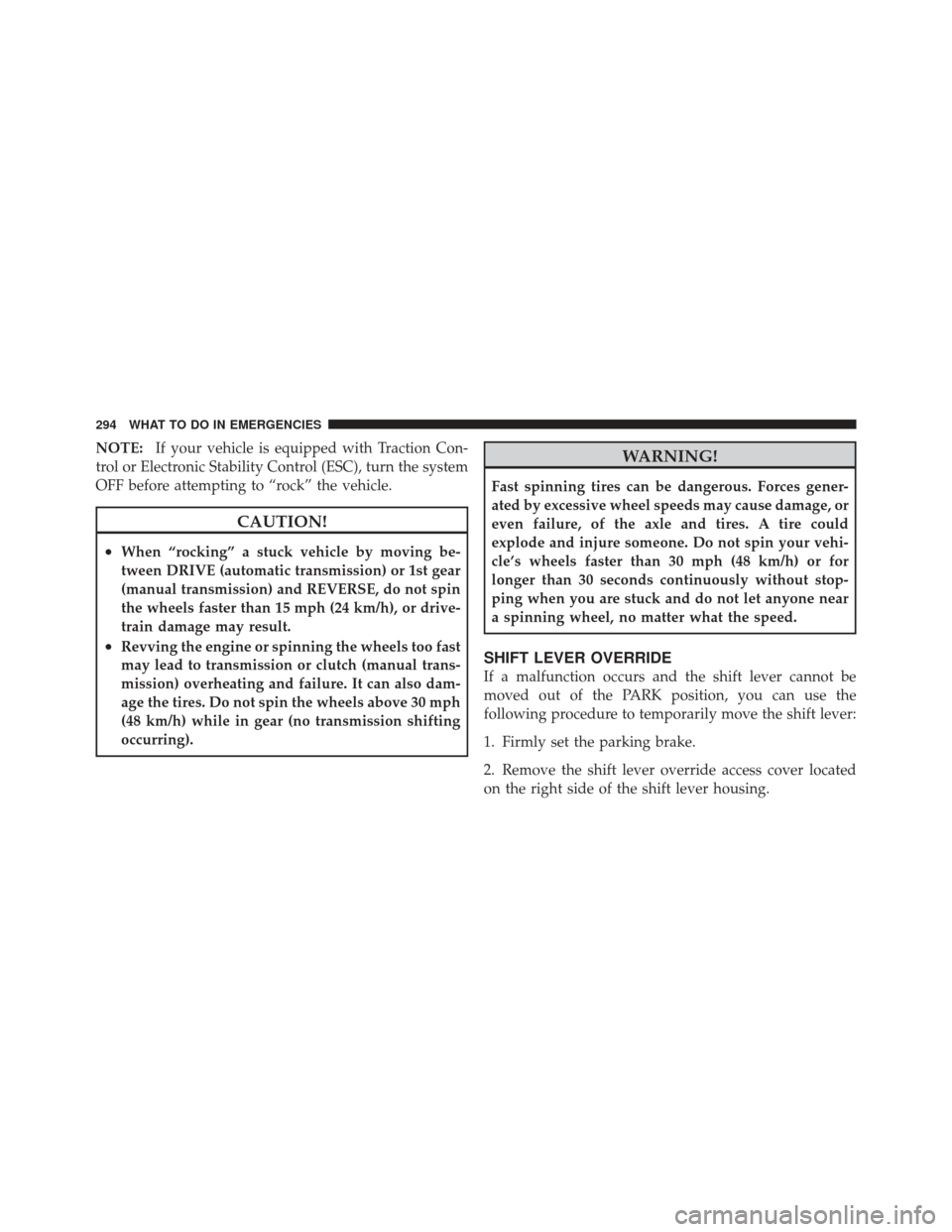
NOTE:If your vehicle is equipped with Traction Con-
trol or Electronic Stability Control (ESC), turn the system
OFF before attempting to “rock” the vehicle.
CAUTION!
•When “rocking” a stuck vehicle by moving be-
tween DRIVE (automatic transmission) or 1st gear
(manual transmission) and REVERSE, do not spin
the wheels faster than 15 mph (24 km/h), or drive-
train damage may result.
•Revving the engine or spinning the wheels too fast
may lead to transmission or clutch (manual trans-
mission) overheating and failure. It can also dam-
age the tires. Do not spin the wheels above 30 mph
(48 km/h) while in gear (no transmission shifting
occurring).
WARNING!
Fast spinning tires can be dangerous. Forces gener-
ated by excessive wheel speeds may cause damage, or
even failure, of the axle and tires. A tire could
explode and injure someone. Do not spin your vehi-
cle’s wheels faster than 30 mph (48 km/h) or for
longer than 30 seconds continuously without stop-
ping when you are stuck and do not let anyone near
a spinning wheel, no matter what the speed.
SHIFT LEVER OVERRIDE
If a malfunction occurs and the shift lever cannot be
moved out of the PARK position, you can use the
following procedure to temporarily move the shift lever:
1. Firmly set the parking brake.
2. Remove the shift lever override access cover located
on the right side of the shift lever housing.
294 WHAT TO DO IN EMERGENCIES
Page 318 of 391
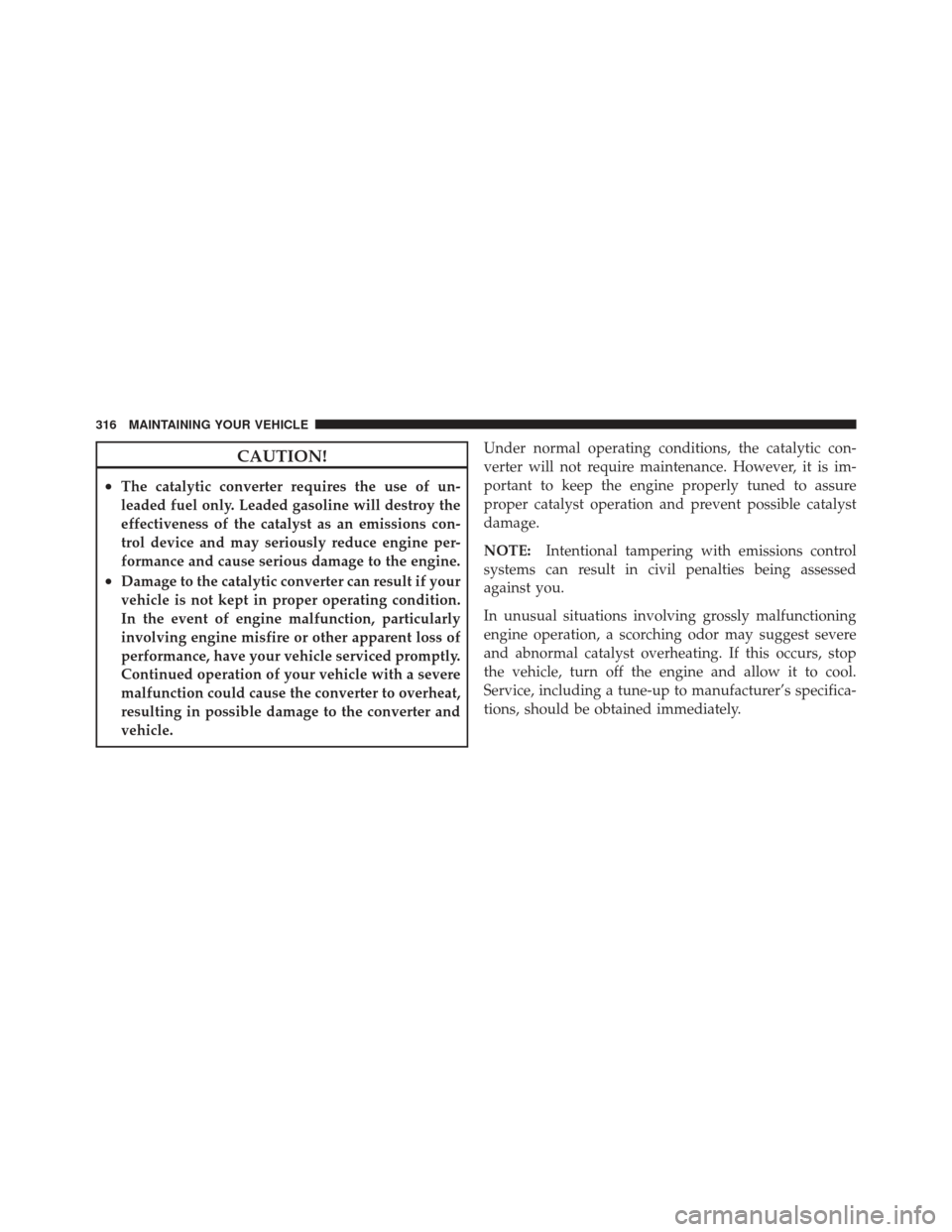
CAUTION!
•The catalytic converter requires the use of un-
leaded fuel only. Leaded gasoline will destroy the
effectiveness of the catalyst as an emissions con-
trol device and may seriously reduce engine per-
formance and cause serious damage to the engine.
•Damage to the catalytic converter can result if your
vehicle is not kept in proper operating condition.
In the event of engine malfunction, particularly
involving engine misfire or other apparent loss of
performance, have your vehicle serviced promptly.
Continued operation of your vehicle with a severe
malfunction could cause the converter to overheat,
resulting in possible damage to the converter and
vehicle.Under normal operating conditions, the catalytic con-
verter will not require maintenance. However, it is im-
portant to keep the engine properly tuned to assure
proper catalyst operation and prevent possible catalyst
damage.
NOTE:
Intentional tampering with emissions control
systems can result in civil penalties being assessed
against you.
In unusual situations involving grossly malfunctioning
engine operation, a scorching odor may suggest severe
and abnormal catalyst overheating. If this occurs, stop
the vehicle, turn off the engine and allow it to cool.
Service, including a tune-up to manufacturer’s specifica-
tions, should be obtained immediately.
316 MAINTAINING YOUR VEHICLE
Page 322 of 391
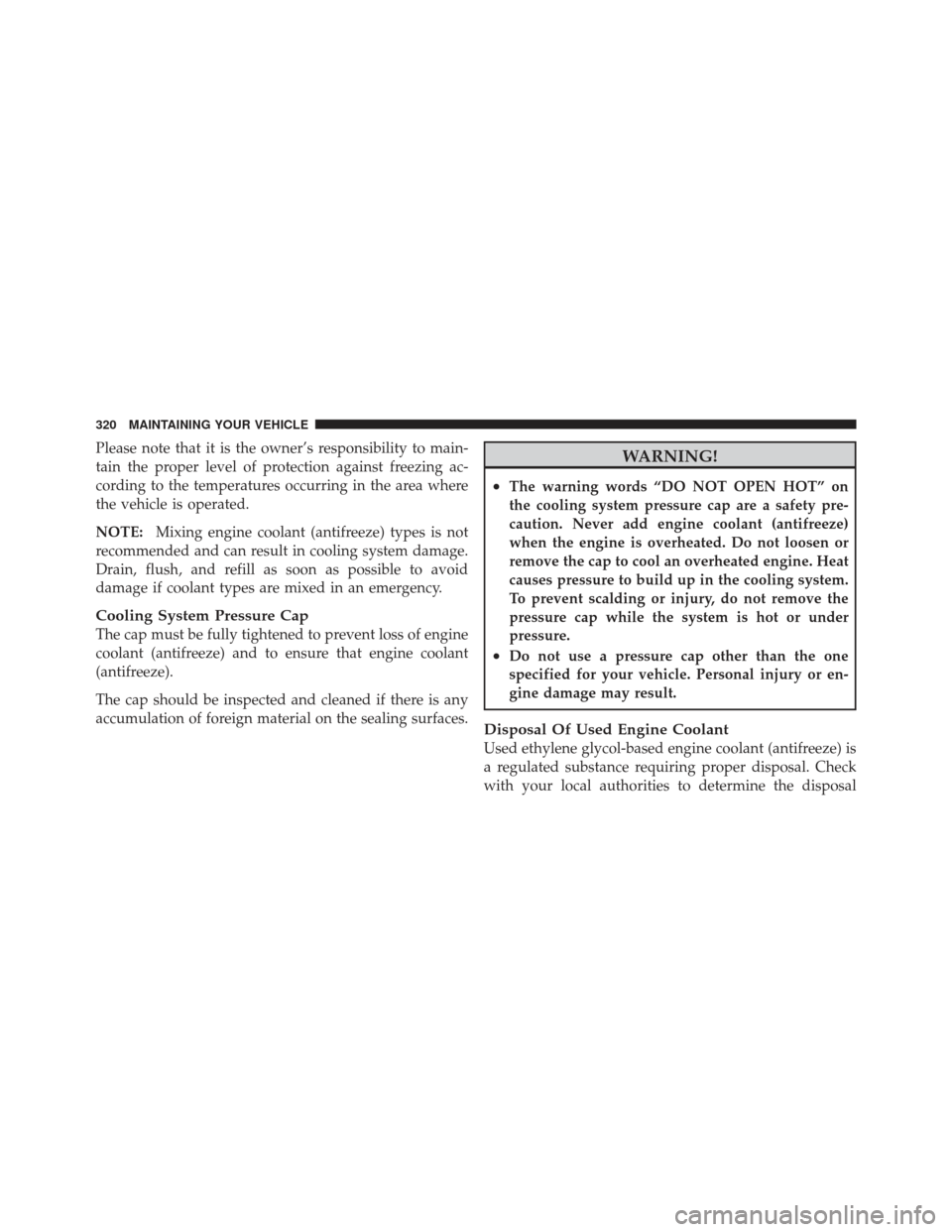
Please note that it is the owner’s responsibility to main-
tain the proper level of protection against freezing ac-
cording to the temperatures occurring in the area where
the vehicle is operated.
NOTE:Mixing engine coolant (antifreeze) types is not
recommended and can result in cooling system damage.
Drain, flush, and refill as soon as possible to avoid
damage if coolant types are mixed in an emergency.
Cooling System Pressure Cap
The cap must be fully tightened to prevent loss of engine
coolant (antifreeze) and to ensure that engine coolant
(antifreeze).
The cap should be inspected and cleaned if there is any
accumulation of foreign material on the sealing surfaces.
WARNING!
•The warning words “DO NOT OPEN HOT” on
the cooling system pressure cap are a safety pre-
caution. Never add engine coolant (antifreeze)
when the engine is overheated. Do not loosen or
remove the cap to cool an overheated engine. Heat
causes pressure to build up in the cooling system.
To prevent scalding or injury, do not remove the
pressure cap while the system is hot or under
pressure.
•Do not use a pressure cap other than the one
specified for your vehicle. Personal injury or en-
gine damage may result.
Disposal Of Used Engine Coolant
Used ethylene glycol-based engine coolant (antifreeze) is
a regulated substance requiring proper disposal. Check
with your local authorities to determine the disposal
320 MAINTAINING YOUR VEHICLE
Page 380 of 391
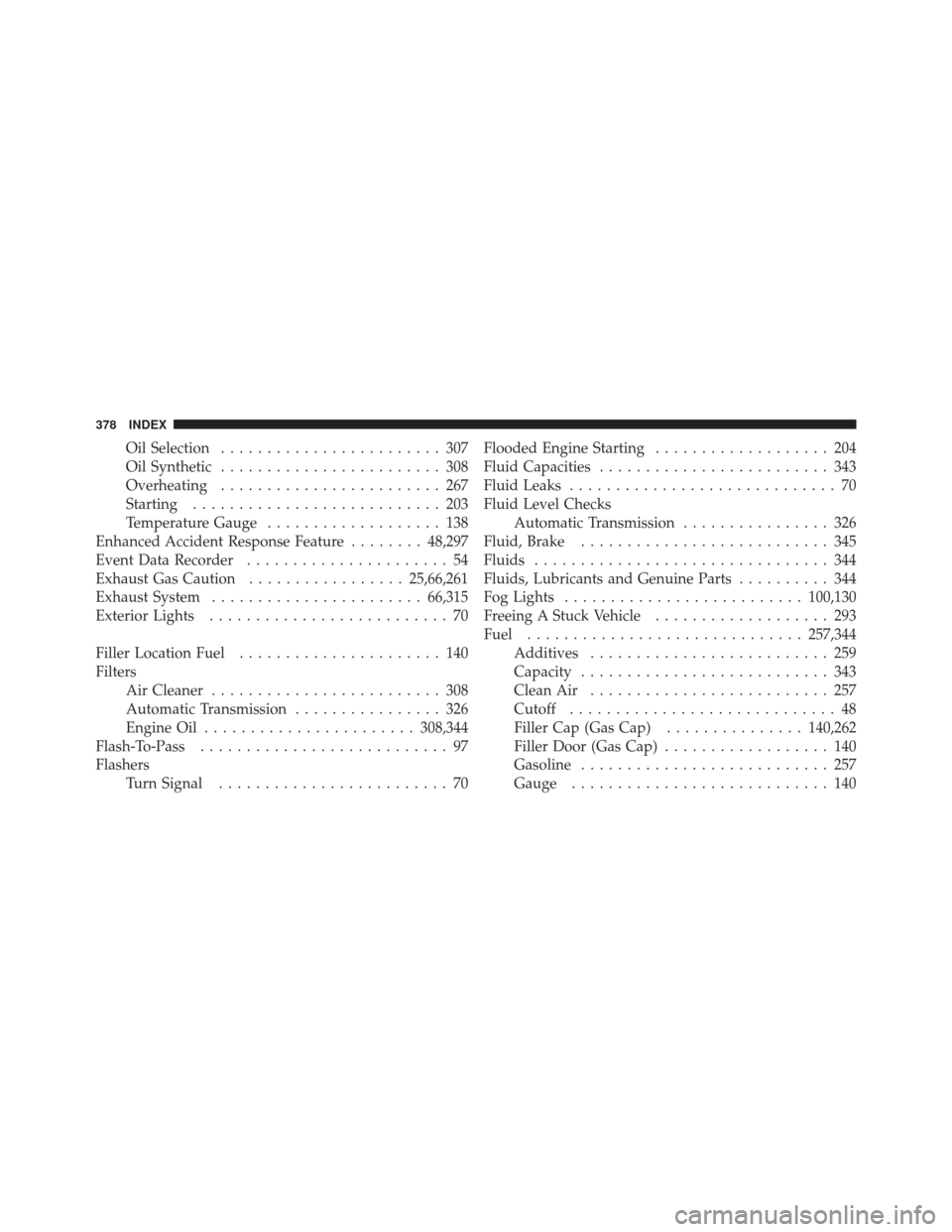
Oil Selection........................ 307
Oil Synthetic ........................ 308
Overheating ........................ 267
Starting ........................... 203
Temperature Gauge ................... 138
Enhanced Accident Response Feature ........48,297
Event Data Recorder ...................... 54
Exhaust Gas Caution ................. 25,66,261
Exhaust System ....................... 66,315
Exterior Lights .......................... 70
Filler Location Fuel ...................... 140
Filters Air Cleaner ......................... 308
Automatic Transmission ................ 326
Engine Oil ....................... 308,344
Flash-To-Pass ........................... 97
Flashers Turn Signal ......................... 70 Flooded Engine Starting
................... 204
Fluid Capacities ......................... 343
Fluid Leaks ............................. 70
Fluid Level Checks Automatic Transmission ................ 326
Fluid, Brake ........................... 345
Fluids ................................ 344
Fluids, Lubricants and Genuine Parts .......... 344
Fog Lights .......................... 100,130
Freeing A Stuck Vehicle ................... 293
Fuel .............................. 257,344
Additives .......................... 259
Capacity ........................... 343
Clean Air .......................... 257
Cutoff ............................. 48
Filler Cap (Gas Cap) ...............140,262
Filler Door (Gas Cap) .................. 140
Gasoline ........................... 257
Gauge ............................ 140
378 INDEX
Page 384 of 391

New Vehicle Break-In Period................ 65
Occupant Restraints ..................... 44,50
Occupant Restraints (Sedan) ...........25,42,44,48
Octane Rating, Gasoline (Fuel) .............. 257
Odometer ............................. 139
Trip .............................. 139
Oil Change Indicator ..................... 145
Oil Change Indicator, Reset ................. 145
Oil, Engine ......................... 306,343
Capacity ........................... 343
Change Interval ..................... 306
Checking .......................... 306
Disposal ........................... 308
Filter ............................. 308
Identification Logo ................... 307
Materials Added to ................... 308
Recommendation .................. 307,343
Synthetic .......................... 308 Viscosity
........................... 307
Onboard Diagnostic System ................ 302
Operator Manual (Owner’s Manual) ............ 4
Overheating, Engine ................... 138,267
Owner’s Manual (Operator Manual) .........4,369
Paint Care ............................. 326
Parking Brake .......................... 220
Pets .................................. 65
Placard, Tire and Loading Information ......... 238
Power Door Locks ......................... 21
Mirrors ............................ 78
Outlet (Auxiliary Electrical Outlet) ........ 117
Steering ........................... 219
Sunroof ........................... 114
Windows ........................... 22
Power Steering Fluid ..................... 345
Pregnant Women and Seat Belts .............. 38
382 INDEX